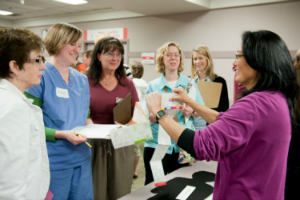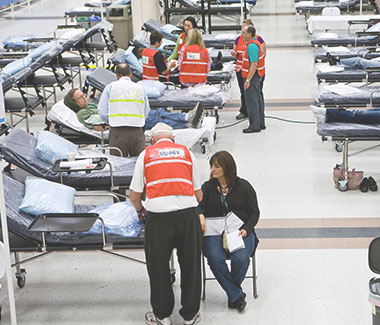

Getting the right patient to the right place during an evacuation
When a mock fire inside Swedish Medical Center’s First Hill Campus in Seattle damaged the primary electricity supply and generator on March 31, 2011, dozens of hospitals and emergency response agencies worked together during a disaster drill to evacuate 133 pediatric patients, 75 of whom required transfer to a Neonatal Intensive Care Unit (NICU).
Healthcare for All Populations
“It is very daunting to think about all of the necessary elements needed to ensure a safe and effective evacuation,” says Cindy Miron, Emergency Preparedness Program Manager at the Tacoma-Pierce County Health Department. “Knowing that none of us is alone and we can rely on partners is so important, as is knowing what each other’s roles are.”
In the 2011 exercise, some patients were sent to facilities that were not capable of providing the level of care they needed, forcing the receiving hospitals to stabilize and transfer them again, a risky and avoidable extra step brought on by a lack of understanding of which regional hospitals had certain specialty services, recalls Eileen Newton, Emergency Preparedness Manager for CHI Franciscan Health, which participated in the exercise. “Swedish First Hill cares for some of the sickest babies there are,” she says. “You can’t just move them to any hospital. Most hospitals don’t have a NICU, let alone a NICU that provides as high of a level of care.”
The same is true for adult patients who need specialty care. From heart-lung bypass machines and continuous dialysis to behavioral healthcare for patients who are incarcerated, there are many services that are provided only at certain hospitals. Yet at the time of the exercise, there was no index of which hospitals provided which services. “If you don’t have that information in advance, you slow down your ability to respond appropriately, because you’re having to get it on the spot, likely with compromised communication systems,” says Barb Graff, Director of the Seattle Office of Emergency Management.
As the regional healthcare coalition, the Northwest Healthcare Response Network (the Network) has created regional plans for evacuating and distributing hospital patients, as well as exercises to test them and identify gaps in preparedness.
Developing a Solution
In Spring 2016, the Network created a list of 70 specialty services and hired consultants to conduct a survey to determine which among 33 hospitals and acute care facilities in King and Pierce counties could provide them. When the project wraps up in 2017, the information will help each county’s Disaster Medical Control Center (DMCC)—the hospital responsible for coordinating the distribution of patients in the event of an evacuation—save time when placing patients.
Preparing as a Community
Exercises have also revealed the need for the local healthcare community to be prepared to help itself during a disaster, rather than rely on outside resources that may be in short supply. In the Cascadia Rising exercise, sponsored by the Federal Emergency Management Agency in June 2016, the entire region simulated a 9.0 earthquake.
As part of the exercise, St. Clare Hospital, a 106-bed CHI Franciscan facility in Lakewood, Washington, learned that its local water district had installed earthquake sensors as a safety measure that would automatically shut off the water supply in the event of tremors. The lack of water would make it impossible for St. Clare’s to maintain its environment of care, forcing administrators to evacuate the building.
Although the healthcare players in the exercise recognized the enormous complexity of evacuating the community’s sole hospital, its plight was low on the list of federal and state priorities. This signaled to Newton the important role that coalition-based collaboration has in creating regional healthcare resilience.
The Value of the Network
“Before the Network it felt like we were running from one exercise to another and we knew we had all these gaps, but we really didn’t have a strategic plan for how we were going to address them,” she says. “We have to be able to continue to provide care to patients under any condition. The Network is helping us accomplish that. They’re helping make healthcare agencies stronger and more prepared to deal with all types of disasters.”
Although healthcare agencies and their emergency response partners agree that a hospital evacuation would require community-wide coordination and support, no government agency has the mandate or resources to maintain a regional healthcare evacuation plan. That work falls to the Network.
“Healthcare organizations are required to have plans and procedures in place to respond to disasters and emergencies and they do a really good job at that,” says the Network’s Planning and Preparedness Manager Aaron Resnick. “But without organizations like the Network and other coalitions, there are no mechanisms to plan for emergencies outside of the walls of any individual healthcare institution.”
In A Disaster
The work of the coalition allows healthcare in our community to:
- Follow up-to-date, practiced regional evacuation plans for hospitals and long-term care facilities
- Place specialty patients in hospitals that can provide the level of care they need
- Track and reunify patients and families
- Share information and resources
- Work together to be self-sufficient
Other Impact Stories

Impact Focus:
Multi-Agency Coordination
Ensuring Capacity...
The Challenge At least 25% of the population of the state of Washington is a pediatric patient, specifically under the… Read more »

Impact Focus:
Evacuation
Partnerships and...
Challenge: Relocating 77 vulnerable residents from a skilled nursing facility in rural Washington during a fire evacuation emergency. Montesano, Washington… Read more »

Impact Focus:
Situational Awareness
Extreme Heat...
The Network spearheads coordination and collaboration to save lives during an extreme heat response. In late June 2021, amidst a… Read more »

